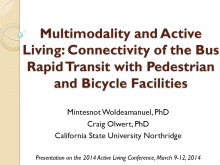We are pleased to announce an exciting new alliance between Active Living Research and GP RED to co-host and coordinate...
Multimodality and Active Living: Connectivity of the Bus Rapid Transit with Pedestrian and Bicycle Facilities

Presentation at the 2014 Active Living Research Annual Conference.
Background and Purpose
Multimodal connectivity refers to the movement of people that involves two or more modes of transport in a single journey. Several studies highlight the importance of multimodal travel approach to meet con¬temporary mobility challenges, such as the need to achieve socioeconomic equity or to reduce environmental impacts associated with urban transportation (Fábio and Fernando 2012). A Bus Rapid Transit (BRT) system can achieve significantly greater CO2 reductions and encourage active lifestyles if it is planned and implemented with a multimodal approach, integrating walking, bicycling, and car (Vincent and Jerram 2006; Litman 2012). Thus, the focus of this research is to analyze the current transportation infrastructure around stations of a BRT, the Metro Orange Line of San Fernando Valley in Los Angeles and to examine if it is designed to promote multimodality. We observe whether the infrastructure connects pedestrians, cyclists, taxis and car users to each station in a way that encourages multimodal transportation.
Objectives
The aim of this research is to investigate whether, and how, the Orange Line in San Fernando Valley has infrastructure to support a multimodal use of the system. A detailed analysis of pedestrian, bicycle, and auto links to the Orange Line was performed in April and May 2013. Based on the results, some recommendations are presented for enhancing the multimodal connectivity of the BRT for a maximum travel experience.
Methods
The study is based on a structured field observation of the Orange Line’s eighteen stations to determine whether they were, or could be, integrated with other means of transportation. Eighteen field evaluation cards were prepared for all the stations. A card includes evaluation criteria for various modes supposedly to be connected to the Orange Line. For integration with the pedestrian mode, the existence of a crosswalk near the station and the quality of the sidewalks within a 350ft radius of the terminal were considered. To analyze the condition of a sidewalk, its width (a good sidewalk being deemed to have a minimum of 4ft width) and the quality of its surface were examined. Terminal accessibility for people with disabilities was also monitored. For bicycles, the presence of bicycle lanes or paths leading to the stops or the vicinity of the terminal was evaluated, as well as availability of bicycle parking. For privately owned cars, the number of parking slots and the presence of park and ride facilities were examined. Once the field data was gathered and compiled, a statistical and spatial analysis was made using statistical software and Geographical Information Systems (GIS) to create a multimodal connectivity index for each station. The index then will be correlated to the socio-demographic and economic background of the area where the station rests.
Results
The calculated Multimodality Index (MI) is adequately differentiated to provide analytical insight. The three stations with the lowest MI were De Soto, Woodman, Valley College and Lauren Canyon. Two of these stations, De Soto and Valley College, are located by the Valley’s two major community colleges. Improved multimodal connectivity to the BRT might increase student use of the Orange Line. One sub-index of the MI, the sidewalk rating, averaged 3.64 (out of 5). The stations with the highest rated sidewalks are Warner Center and Sepulveda, with ratings above 4.5. The stations with the lowest sidewalk ratings are De Soto, Valley College, and Woodman, with ratings below 2.8. Other sub-indices such as the availability of bicycling facilities, parking lots, kiss-n-ride opportunities and facilities for disabilities indicates that some stations need significant improvements to encourage a multimodal travel experience for BRT users.
Conclusions
The current transportation infrastructure of the Metro Orange Line does not fully promote multimodal connectivity. Increasing multimodal access to each Metro station promotes active transportation in the San Fernando Valley. Pedestrians and cyclists are the primary target because they use healthy, non-motorized modes to access the Orange Line. With regard to private cars, improved connectivity with BRT provides apparent environmental benefits, and can provide some social, and public health advantages.
Implications for Practice and Policy
The proposed research has empirical, conceptual and methodological contributions such as measuring the extent of multimodality of Bus Rapid Transit systems. The application of the analysis method introduced in this study is not limited to the Orange Line but it can be extended to the analysis of any BRT system. Besides, the results of this study would serve as indicator as to whether there is a lack of multimodality for different stations of the Bus Rapid Transit, so the empirical findings of this research will also have important implications for local transit planning.
References
- Fábio D., and R. Fernando. 2012. Intermodal Connectivity to BRT: A Comparative Analysis of Bogotá and Curitiba. Journal of Public Transportation, Vol. 15, No. 2, pp. 1-18.
- Vincent, W., and L. Jerram. 2006. The Potential for Bus Rapid Transit to Reduce Transportation-related CO2 Emissions. Journal of Public Transportation, BRT Special Edition: pp. 219–237.
- Litman, T. 2012. Introduction to Multi-Modal Transportation Planning: Principles and Practices, Victoria Transport Policy Institute
Support / Funding Source
This study is supported by a Research Grant from the College of Social and Behavioral Sciences (CSBS), California State University Northridge (CSUN).
- DOWNLOAD "2014_ActiveTransportation_Woldeamanuel.pdf" PDF (1.47 MB) Presentations
STAY UP TO DATE
RECENTLY ADDED TOOLS & RESOURCES
MOVE! A BLOG ABOUT ACTIVE LIVING
The "Active Living Conference" aims to break down research and practice silos and...







